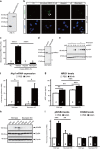Ablation of neuropsin-neuregulin 1 signaling imbalances ErbB4 inhibitory networks and disrupts hippocampal gamma oscillation
- PMID: 28267150
- PMCID: PMC5416666
- DOI: 10.1038/tp.2017.20
Ablation of neuropsin-neuregulin 1 signaling imbalances ErbB4 inhibitory networks and disrupts hippocampal gamma oscillation
Abstract
Parvalbumin-expressing interneurons are pivotal for the processing of information in healthy brain, whereas the coordination of these functions is seriously disrupted in diseased brain. How these interneurons in the hippocampus participate in pathological functions remains unclear. We previously reported that neuregulin 1 (NRG1)-ErbB4 signaling, which is actuated by neuropsin, is important for coordinating brain plasticity. Neuropsin cleaves mature NRG1 (bound to extracellular glycosaminoglycans) in response to long-term potentiation or depression, liberating a soluble ligand that activates its receptor, ErbB4. Here, we show in mice that kainate-induced status epilepticus transiently elevates the proteolytic activity of neuropsin and stimulates cFos expression with a time course suggesting that activation of ErbB4- and parvalbumin-expressing interneurons follows the excitation and subsequent silencing of pyramidal neurons. In neuropsin-deficient mice, kainate administration impaired signaling and disrupted the neuronal excitation-inhibition balance (E/I balance) in hippocampal networks, by decreasing the activity of parvalbumin-positive interneurons while increasing that of pyramidal neurons, resulting in the progression of status epilepticus. Slow, but not fast, gamma oscillations in neuropsin-deficient mice showed reduced power. Intracerebroventricular infusion of the soluble NRG1 ligand moiety restored the E/I balance, status epilepticus and gamma oscillations to normal levels. These results suggest that the neuropsin-NRG1 signaling system has a role in pathological processes underlying temporal lobe epilepsy by regulating the activity of parvalbumin-expressing interneurons, and that neuropsin regulates E/I balance and gamma oscillations through NRG1-ErbB4 signaling toward parvalbumin-expressing interneurons. This neuronal system may be a useful target of pharmacological therapies against cognitive disorders.
Conflict of interest statement
The authors declare no conflict of interest.
Figures






Similar articles
-
Neuroinflammation-Induced Downregulation of Hippocampacal Neuregulin 1-ErbB4 Signaling in the Parvalbumin Interneurons Might Contribute to Cognitive Impairment in a Mouse Model of Sepsis-Associated Encephalopathy.Inflammation. 2017 Apr;40(2):387-400. doi: 10.1007/s10753-016-0484-2. Inflammation. 2017. PMID: 27913953
-
ErbB4 in parvalbumin-positive interneurons is critical for neuregulin 1 regulation of long-term potentiation.Proc Natl Acad Sci U S A. 2010 Dec 14;107(50):21818-23. doi: 10.1073/pnas.1010669107. Epub 2010 Nov 24. Proc Natl Acad Sci U S A. 2010. PMID: 21106764 Free PMC article.
-
Neuregulin 1 Type I Overexpression Is Associated with Reduced NMDA Receptor-Mediated Synaptic Signaling in Hippocampal Interneurons Expressing PV or CCK.eNeuro. 2018 May 8;5(2):ENEURO.0418-17.2018. doi: 10.1523/ENEURO.0418-17.2018. eCollection 2018 Mar-Apr. eNeuro. 2018. PMID: 29740596 Free PMC article.
-
Trophic modulation of gamma oscillations: The key role of processing protease for Neuregulin-1 and BDNF precursors.Neurochem Int. 2018 Oct;119:2-10. doi: 10.1016/j.neuint.2017.12.002. Epub 2017 Dec 9. Neurochem Int. 2018. PMID: 29233654 Review.
-
The role of the neuregulin 1-ErbB4 signaling pathway in neurological disorders.J Physiol Pharmacol. 2024 Dec;75(6). doi: 10.26402/jpp.2024.6.01. Epub 2025 Feb 3. J Physiol Pharmacol. 2024. PMID: 39923224 Review.
Cited by
-
Impairments of GABAergic transmission in hippocampus mediate increased susceptibility of epilepsy in the early stage of Alzheimer's disease.Cell Commun Signal. 2024 Feb 22;22(1):147. doi: 10.1186/s12964-024-01528-7. Cell Commun Signal. 2024. PMID: 38388921 Free PMC article.
-
Somatostatin interneurons exhibit enhanced functional output and resilience to axotomy after mild traumatic brain injury.Neurobiol Dis. 2022 Sep;171:105801. doi: 10.1016/j.nbd.2022.105801. Epub 2022 Jun 23. Neurobiol Dis. 2022. PMID: 35753625 Free PMC article.
-
ErbB4 Null Mice Display Altered Mesocorticolimbic and Nigrostriatal Dopamine Levels as well as Deficits in Cognitive and Motivational Behaviors.eNeuro. 2020 May 21;7(3):ENEURO.0395-19.2020. doi: 10.1523/ENEURO.0395-19.2020. Print 2020 May/Jun. eNeuro. 2020. PMID: 32354758 Free PMC article.
-
M1 muscarinic receptor is a key target of neuroprotection, neuroregeneration and memory recovery by i-Extract from Withania somnifera.Sci Rep. 2019 Sep 30;9(1):13990. doi: 10.1038/s41598-019-48238-6. Sci Rep. 2019. PMID: 31570736 Free PMC article.
-
The effect of pharmacological inhibition of Serine Proteases on neuronal networks in vitro.PeerJ. 2019 Apr 23;7:e6796. doi: 10.7717/peerj.6796. eCollection 2019. PeerJ. 2019. PMID: 31065460 Free PMC article.
References
Publication types
MeSH terms
Substances
LinkOut - more resources
Full Text Sources
Other Literature Sources
Molecular Biology Databases

